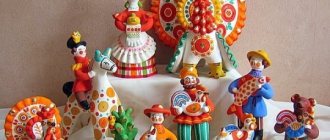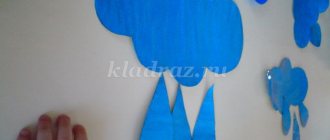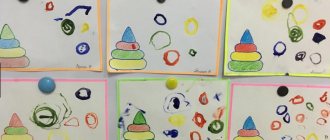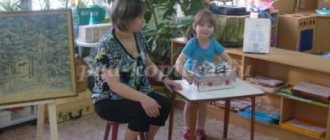On the topic: methodological developments, presentations and notes
Abstract of GCD in the 2nd group of early age, direction "Artistic and aesthetic development. Modeling." Topic: Nuts for the squirrel.
Summary of educational activities in the 2nd group of early age. Direction Artistic and aesthetic development. Application. Topic: “Autumn leaves.”
Topics, tasks, equipment for art classes for young children.
Summary of a lesson for children of the younger group on miraculous aesthetic development (modeling) “Let's decorate a cup.”
Summary of an educational activity for young children on artistic and aesthetic development (growing) “Rays for the sun.”
Topic: "Drawing a fairy tale."
laquo;The origins of children’s abilities and talents are at their fingertips. From the fingers, figuratively speaking, come the finest threads - streams that feed the source of creative thought. In other words.
Source
Summary of a lesson in the first junior group on the topic “Non-traditional types of drawing”
Open lesson in the first junior group “Rodnichok”
Unconventional drawing on the theme: “Let’s hide the bunny”
Goal: to consolidate the technique of drawing with cotton using the “dipping” method.
Program tasks: improve the ability to examine objects: learn to examine, feel. Learn to draw snow by “dipping” cotton wool onto a sheet of paper. Develop fine motor skills and a sense of rhythm. Cultivate curiosity and interest in drawing . Enrich passive vocabulary. Activate children's speech by encouraging them to repeat words after the teacher.
Drawing technique : dipping cotton wool onto a sheet of paper (snow).
Equipment and handouts: tinted album sheets with painted bunnies , white cotton wool, white gouache, dishes for cotton wool, rags, jars of water; a bucket of snow, a toy hare, a musical recording in the rhythm of a waltz, a book with drawings “Winter Poems”.
Vocabulary work: white, fluffy, cold, snow, light, snowflake.
Preliminary work: playing with snow; reading poems about winter.
Progress of the lesson:
(The teacher brings a bucket of snow to the group and holds a toy hare in his hands.)
- Guys, I went outside to get some snow and saw a bunny sitting under a bush and crying . I felt sorry for him, and I brought him to our group . Look how nice and small he is. But he is crying. Let's ask why he's crying. (Children ask: why are you crying, bunny ?
The bunny “tells” that winter has come, and he changed his fur coat to white so that he would not be visible in the snow. But very little snow has fallen, and it is noticeable on the ground. The fox might catch him.)
Guys, let's help the bunny and draw a lot, a lot of snow, and it won't be visible.
(Show the children a picture of a winter forest, draw the children’s attention to how much snow there is, big snowdrifts everywhere, that all the trees are dressed in a beautiful snowy outfit.)
- It was the snow that wrapped their branches so that the trees would not freeze in winter. Have you seen how the snowball spins in the air? Show. Physical exercise “Snowflakes”.
(Children spin and show how snowflakes spin to the music.)
“And one snowflake landed on my sleeve, I blew on it, and the snowflake flew to the ground.” She is light and fluffy, like cotton wool. - Children, what is a snowflake? - Light, white, fluffy. - That's right, children, well done.
(Give the children pieces of cotton wool and invite them to play with the “snowflake” and blow on it.)
White fluffy snow
Spinning in the air.
And the ground is quiet
Falls, lies down.
- And you and I can draw how a snowball is falling quietly, white, pure, like fluff. And we'll hide the bunny . Cotton wool and paint will help us.
- Sit down at the tables. On your tables are sheets of paper with pictures of bunnies . Draw lots and lots of snow for the bunnies . What color paint should we use? (White.)
- But first, let’s remember how to hold cotton wool correctly. (Show an exercise for fingers: the tips of the thumb and index finger are pressed against each other (beak), the rest of the fingers move freely (wing).
- Look, my palm is turning into a bird. Here is the beak and wing. Let your palms turn into a bird. Now take the cotton wool with the “beak” and fold it into the “wing”.
(Children hold the cotton wool on one side with their index finger and on the other with their thumb. The remaining three fingers are pressed against each other and hold the cotton wool from below.)
- Show with dry cotton how you can draw snow (apply - remove).
(Children put paint on the tip and get to work. The teacher, if necessary, helps and tells how to work with cotton wool correctly.)
-Children, snowflake, what is it?
-She is white and fluffy, like snow. Do you want to play with snow some more?
(Show the bucket, there is no more snow in it, it has melted in the warmth.)
-And our snowball in the drawings will not melt, because we painted it with paint .
(The lesson ends with the game “Snowflakes are Spinning”: children run in a circle to the music, do a spin instead of music, and at the end of the music they squat down and lower their hands.)
The bunny thanks the children and runs away into the forest.
-Children, what activity did we have today? - Drawing.
-What did we draw in class today?
Lots and lots of snow for the bunny. Thank you, children, today we helped the bunny hide from the sly fox. Now the hare is not afraid of the fox. The hare is now invisible in the snow. Well done, children, this ends our lesson.
Borisova Matrena Georgievna, teacher of the Child Development Center - Kindergarten No. 105 "Umka"
On the topic: methodological developments, presentations and notes
Goals: to introduce children to objects in their immediate environment - toys; learn to answer questions, describe a toy and actions with it, carry out simple tasks, compare and distinguish plastic ones, p.
Goal: · To teach children to use words-names to perceive the qualities of an object. · To improve the level.
"A fun journey on a train."
Lesson 3Purpose. Develop interest and respect for theatrical dolls, create a desire to play with them, and the ability to focus your attention on the toy. Maintain the desire to listen to poetry, answer.
Lesson summary for older children. Topic: “Dymkovo toys” Goal: Introducing children to folk culture through familiarization with the Dymkovo toy. Objectives: - To cultivate love and respect.
Maslenitsa is a wonderful, bright and joyful holiday of seeing off winter and welcoming spring. This is a traditional Russian folk holiday: cheerful, noisy, mischievous and very tasty. Every preschooler in our village...
Source
Preview:
Drawing. 1st ml.
Topic: "Funny toys."
Objectives: To arouse interest in looking at pictures in children's books. Show the relationship between pictures and real toys. Learn to recognize and name toys in drawings. Continue to introduce book graphics using the illustrations of A. Barto as an example. Develop aesthetic education. Learn to color outlines. The coloring method is fingerprints or cotton swabs. Learn correctly, hold a brush.
Preliminary work: Reading children's books with Russian folk nursery rhymes, poems and looking at illustrations.
Material: Collections of poems and nursery rhymes. Toys are the heroes of poems and nursery rhymes. Outlines of bears cut out of paper. Brown gouache. Cotton buds. Oilcloth, wet wipes.
- Organizing time. The teacher invites the children to read a book with beautiful pictures. Shows a book (first the cover, then a specific illustration) and reads a poem. A. Barto “The mistress abandoned the bunny.” Shows an illustration and asks who is it? (Bunny). Who abandoned the bunny? (Mistress). What was the bunny sitting on? Why couldn't he get off? (Bench).
Then the teacher puts out several different toys and asks them to find the bunny. Makes a mistake on purpose (for example, points to a bear and asks? “Is this a bunny?”). Makes sure that children have established a connection between the toy and the picture (this is a bunny toy, and this is a bunny picture).
Next, the teacher reads the poem “They dropped the bear on the floor...”. And asks the children to find a character toy among the toys and match it with the picture. Helps establish a connection between toys and pictures - illustrations.
After the children and the teacher have read the poems, the teacher invites the children to dance with the bear and the bunny.
- Music physical min. E. Zheleznova “Brown Bear” No. 41.
- Main activity. Drawing. Then, after physical. min. Shows the outlines of bears cut out of white cardboard and asks the children if they know what kind of toy this is. Invites children to color them with paints so that they become bright and beautiful. (Coloring method - fingerprints or cotton swabs.)
- Reflection. Well done guys, how many bright and beautiful bears we got.
After the lesson: Didactic games “Find a toy”, in which the teacher shows pictures and asks the children to find suitable toys, or vice versa, pictures.




